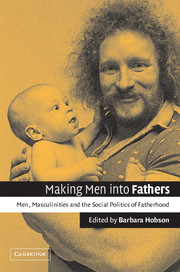Book contents
- Frontmatter
- Contents
- List of figures
- List of tables
- Preface
- Introduction: making men into fathers
- Part 1 Who fathers?
- Part 2 Men in social policy and the logics of cash and care
- 2 Citizens, workers or fathers? Men in the history of US social policy
- 3 Compulsory fatherhood: the coding of fatherhood in the Swedish welfare state
- 4 The problem of fathers: policy and behavior in Britain
- 5 A new role for fathers? The German case
- 6 Transformations of fatherhood: the Netherlands
- Part 3 Resisting and reclaiming fatherhood
- Part 4 Theorizing men, masculinities and fatherhood
- Notes
- References
- Index
2 - Citizens, workers or fathers? Men in the history of US social policy
Published online by Cambridge University Press: 22 September 2009
- Frontmatter
- Contents
- List of figures
- List of tables
- Preface
- Introduction: making men into fathers
- Part 1 Who fathers?
- Part 2 Men in social policy and the logics of cash and care
- 2 Citizens, workers or fathers? Men in the history of US social policy
- 3 Compulsory fatherhood: the coding of fatherhood in the Swedish welfare state
- 4 The problem of fathers: policy and behavior in Britain
- 5 A new role for fathers? The German case
- 6 Transformations of fatherhood: the Netherlands
- Part 3 Resisting and reclaiming fatherhood
- Part 4 Theorizing men, masculinities and fatherhood
- Notes
- References
- Index
Summary
How are fathers treated in US social policy? One might well be stumped by such a question. Recent American social policy debates have swirled around single mothers on welfare and the need to get them into the workforce; only secondarily has attention alighted on the fathers of their children and the need to get them to pay child support. Debates about retirement provision, far weightier than welfare in terms of expenditures and population covered, have been principally about financing; the family status of the workers who collect these benefits is politically beside the point. Indeed, the most salient fact about the treatment of fathers in US social policy is the virtual absence of programs targeting them as fathers. The US welfare state is cross-nationally unusual in the extent to which coverage is limited to elderly, retired workers (both men and women) and very poor single parents, mainly women. The majority of the working-aged population – men, women, fathers, mothers and their children – is simply left outside the umbrella of state social protection, forced to rely on private sources of cash and care: markets and families. But this gap in provision, which is arguably the most consequential feature of the US social policy regime for men who are fathers, has received far less attention from policy makers or policy analysts than welfare or social security.
- Type
- Chapter
- Information
- Making Men into FathersMen, Masculinities and the Social Politics of Fatherhood, pp. 61 - 91Publisher: Cambridge University PressPrint publication year: 2002
- 16
- Cited by



